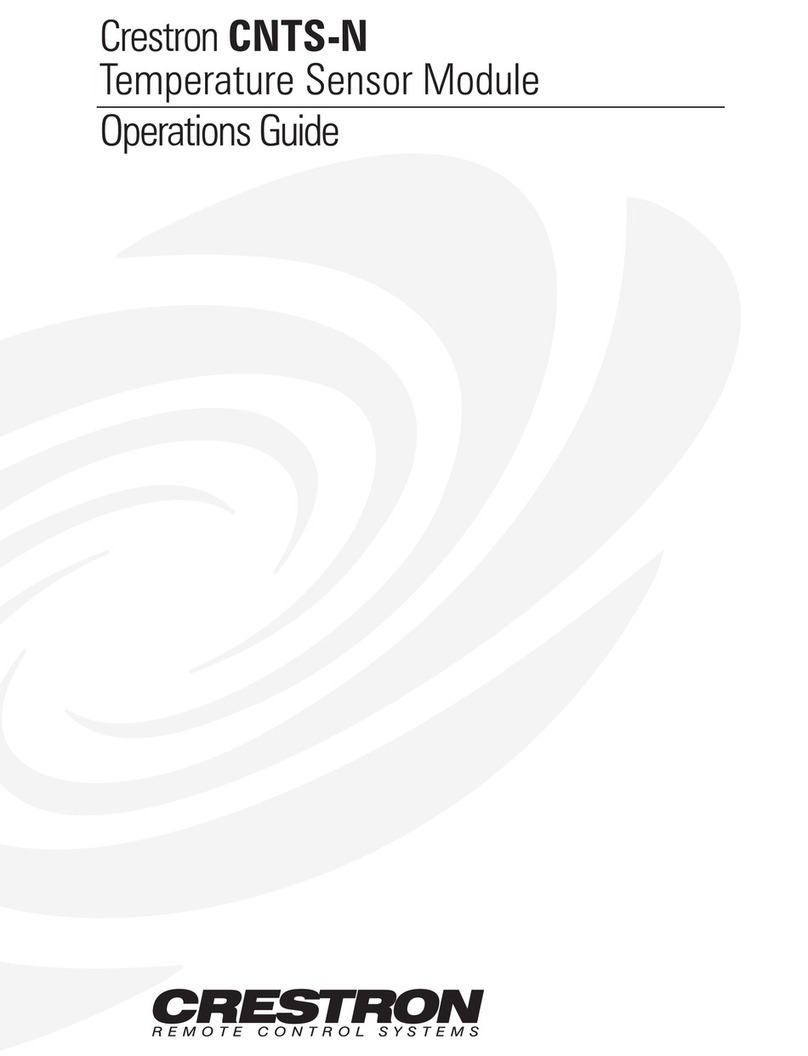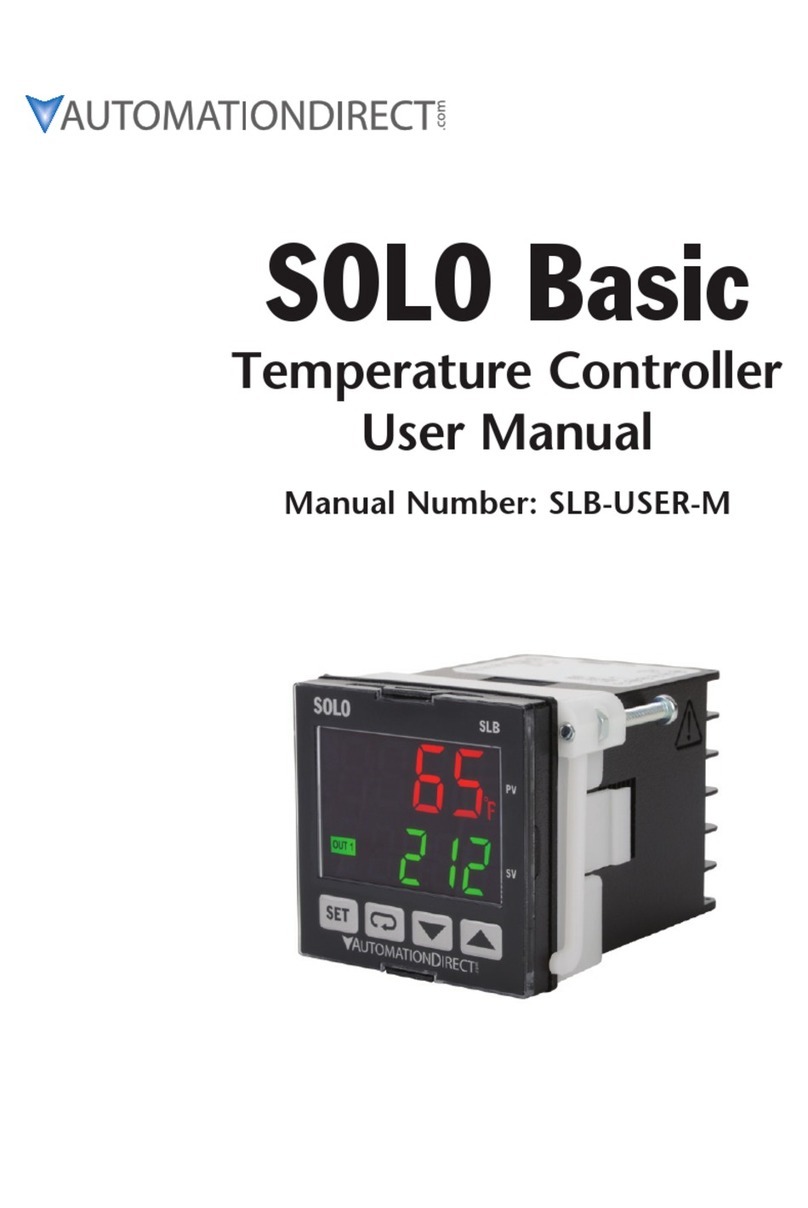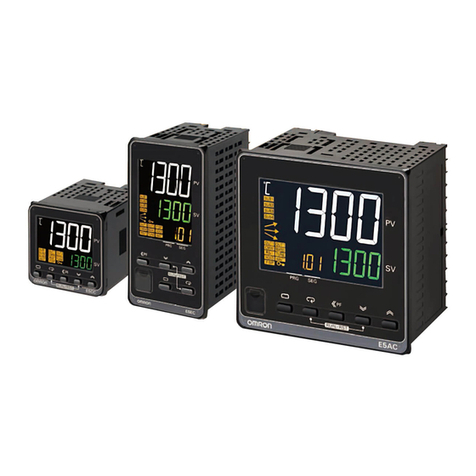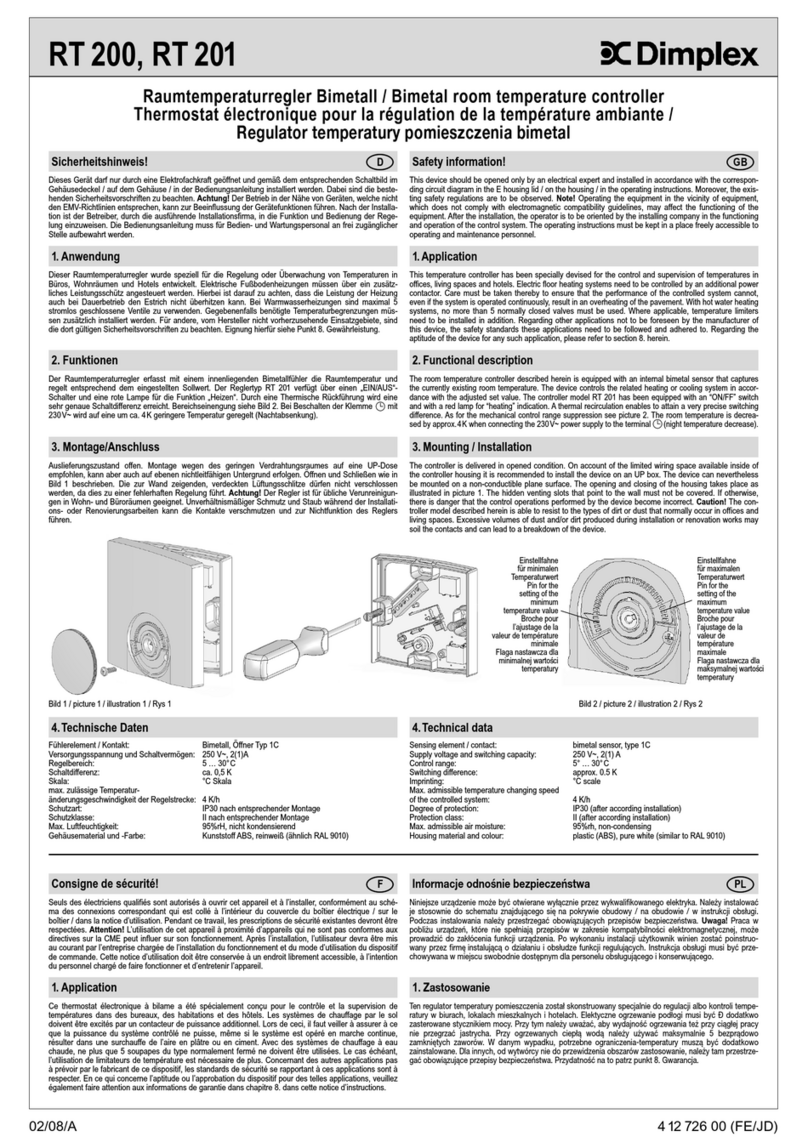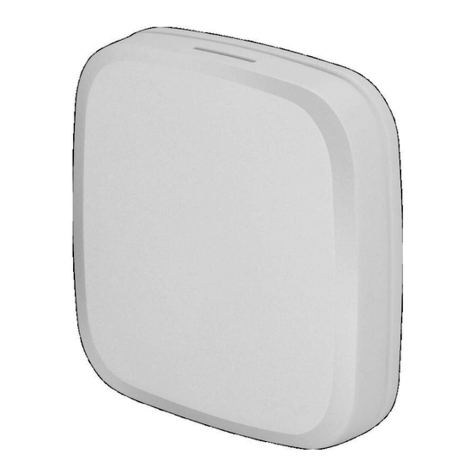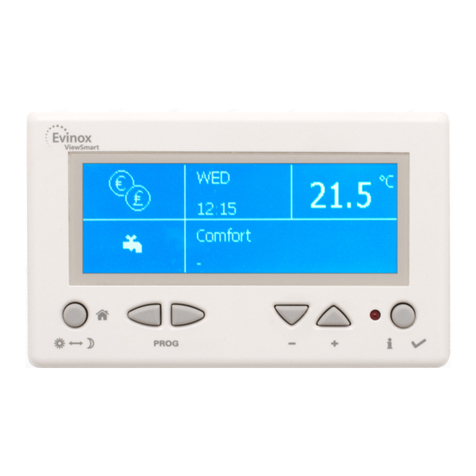JENCO 6308CT User manual

OPERATION MANUAL
JENCO MODEL 6308CT
MICROCOMPUTER BASED
Conductivity/TDS & Temperature
CONTROLLER
JENCO ELECTRONICS,LTD.
MANUFACTURER OF PRECISION INSTRUMENTS

1
CONTENTS page
I. INITIAL INSPECTION and ASSEMBLY 2
MOUNTING PROCEDURE 2
II. GENERAL INTRODUCTION 4
III. USING THE JENCO MODEL 6308CT 5
A.FRONT PANEL 5
B.NORMAL MODE DISPLAY 6
C.REAR CONNECTORS 7
D.TURNING ON/OFF THE INSTRUMENT 8
PROBE HANDLING AND MAINTANCE 9
IV. MODEL 6308CT MODES 10
A. NORMAL MODE 10
B. CALIBRATION/SETTING MODE 13
a.PASSWORD CHECK PAGE 14
b.USER SETTING PAGE 15
c.CONDUCTIVITY CALIBRATION PAGE 15
d.CONDUCTIVITY CONTROL SETTING PAGE 18
e.CURRENT SETTING PAGE 19
f.TEMP. CONTROL SETTING PAGE 20
V. CONTROLLING THE RELAYS 21
A. ISOLATION VOLTAGE 21
B. OUTPUT LOAD 21
C. RELAY ACTION, SETPOINT, HYSTERESIS
MODE & HYSTERESIS VALUE 21
D.CONDUCTIVITY/TDS RELAYS 22
E.TEMPERATURE RELAY 23
VI. 4-20 mA OUTPUT 23
A.ISOLATION VOLTAGE 23
B.OUTPUT LOAD 23
C.CONDUCTIVITY OR TDS LINEAR OUTPUT 23
VII. RS485 INTERFACE OPERATION 25
A.INTRODUCTION 25
B.PREPARING THE METER 25
VIII.ERROR DISPLAYS AND TROUBLESHOOTING 26
IX. SPECIFICATION 27
X. WARRANTY 29

2
I. INITIAL INSPECTION and ASSEMBLY
Carefully unpack the instrument and accessories. Inspect for
damages made in shipment. If any damage is found, notify your
Jenco representative immediately. All packing materials should be
saved until satisfactory operation is confirmed.
MOUNTING PROCEDURE
1. Make a cutout on any panel, with a thickness of 1/16 in. (1.5 mm)
to 3/8 in. (9.5mm).
2. Remove the mounting assembly from the controller and insert the
controller into the cutout.
3. Replace the mounting bracket assembly onto the controller and
secure the controller to the mounting panel.
Warning:
If the equipment is used in a manner not specified by the
manufacturer, the protection provided by the equipment may be
impaired.
3.66" 0.04
0.00
93.00mm
1.00
0.00 93.00mm
3.66" 0.00
0.00
1.00
0.04
0.04"R(1.0mm) MAX.
PANEL CUTOUT DIMENSIONS

3
Cleaning the instrument:
1. Be sure to remove the power before attempting to clean the
meter.
2. Use a lint free cloth and clean water or neutral detergent.
3. Wipe the outer surface of the instrument only.
4. Wipe-dry the instrument before powering again.

4
II. GENERAL INTRODUCTION
The Jenco Model 6308CT (Conductivity and Temperature) System,
is a rugged microprocessor based instrument assembled in a
watertight ¼ DIN case, designed for use in laboratories and process
control applications.
The model 6308CT microprocessor allows the user to easily
recalibrate the parameters for the probes. The Conductivity system
requires only a single calibration. The microprocessor also performs
a self-diagnostic routine every time you turn on the unit providing
you with basic information about the stability of the instrument.
The system simultaneously displays Conductivity, Temperature,
cell constant or TDS factor, relay status and mA output in one LCD
graphic screen. This system uses a two-wire or four-wire type
sensor for the conductivity and a precise thermistor for
temperature, providing you with accurate readings for all your
measurements.
The model 6308CT is equipped with three relays: two
programmable High/Low control relays for conductivity/TDS and
one programmable High/Low control relay for temperature. All
relays are hysteresis driven and configurable to CENTER or EDGE
mode. The system also has an isolated 4-20mA analog output, offset
and span configurable for Conductivity/TDS display.
The model 6308CT comes with a RS485 interface which can easily
let the user log all data (from multiple model 6308 or 6309) with
an IBM©PC/AT compatible computer. For advanced users, the
model 6308CT may also be remotely controlled from main display
mode to all calibration/setting modes.

5
III. USING THE JENCO MODEL 6308CT
A. FRONT PANEL
1. The [MODE/-] key.
1a. In Normal mode this key
will change the display to
Conductivityor TDS.
1b. In Calibration/Setting
mode this key will move
to the next digit of the
current active parameter.
1c. In Calibration/Setting
mode pressing this key for
2 seconds. will move you
back to the previous
parameter. Pressing this
key for 2 seconds at the
first parameter of the page
will move you back to last parameter of the previous page.
2. The [CAL/VIEW] key.
2a. During any normal mode, pressing this key for about 2 secs
will switch to the first Calibration/Setting screen.
2b. During Calibration/Setting mode this key will switch to the
next available Calibration/Setting page pressing this key at
the last User/Calibration page(TEMP. CONTROL SETTING
page) will return the user to the Normal mode.
3. The [ ] UP key.
During Calibration/Setting mode this key will increment the
current blinking digit of the active parameter.
4. The [ ] DOWN key.
During Calibration/Setting mode this key will decrement the
blinking digit of the active parameter.
MODE CAL.
VIEW
CURSOR
JENCO
6308CT

6
5. The [ ] ENTER key.
During Calibration/Setting mode this key will save the
current modified parameter and move to the next parameter
on the page if the parameter is the last one on the page then it
will move to first parameter on the next available page.
6. The [ ] LIGHT key.
This key will turn on or turn off the backlight of the LCD.
The backlight will automatically turn off if there is no key
activity within two minutes.
7. LCD screen.
B. NORMAL MODE DISPLAY
1. CELL or TDS F– Actual
cell constant of the
probe computed from
the last cell constant
calibration. In TDS
display it will show the
TDS factor instead of
the cell constant.
2. CURRENT OUT - this
will display the actual
output of the isolated 4-20 mA output. At POWER-ON this will
show “OFF” for about 3 seconds before going to normal
operation. After going to the Calibration/Setting pages when the
unit is not password locked this will show ”FROZEN” for about
3 seconds before returning to normal operation.
3. ( )key icon annunciator - This will be displayed if the
Calibration /Setting pages are locked, meaning the user will
not be able to change the values unless the correct 4 digit
number has been entered at the PASSWORD CHECK page.
4. H1 or L1 annunciator - this is the status of Conductivity/TDS
1
2
3
4
5
6
7
8
9

7
Relay 1, if this is displayed then the relay is ON. (H stands for
high action control and L stands for low action control)
5. H2 or L2 annunciator – this is the status of Conductivity/TDS
Relay 2, if this is displayed then the relay is ON.
6. H3 or L3 annunciator – this is the status of the Temperature
Relay 3, if this is displayed then the Relay is ON.
7. TC- User selected temperature coefficient of the conductivity/
TDS solution.
8. Conductivity or TDS display.
9. Temperature display.
C. REAR CONNECTORS
Before wiring the probes, relays, analog output, RS485 and power
cord be sure that you are connecting to the right terminal as shown
below (be sure the ac-plug is not plugged-in). Remember that the
unit is ON once the user plugs in the power cord to an AC power
supply.

8
1. Connect the AC line to the rear of the instrument. The model
6308CT can be used with 115 or 230 VAC 50/60 Hz. Power
consumption is 6 watts. Make sure the EARTH connector is
connected to the earth lead of the AC power line.
2. Connect the proper load to the output relays. Make sure that the
load does not exceed the relay rating, 5 Amp at 115 VAC and 2.5
Amp at 230 VAC.
3. Set the proper load to the 4-20mA output connector. Make sure
that the load impedance is less than 500 Ohms.
4. If the user uses a two-wire conductivity probe, the user needs to
short terminal D1 with terminal S1 and terminal D2 with terminal
S2.
CAUTION: Make sure you connect the AC power cord to the
correct AC terminals. Connecting incorrectly may damage the unit
permanently.
D. TURNING ON/OFF THE INSTRUMENT
By just plugging the unit to a
correct AC voltage the unit will be
ready for use. There is no Power
key so unplugging and plugging
the unit will turn OFF or turn ON
the unit respectively.
After the unit is turned on, it will
perform some basic self diagnostics
and will display “OK” or “BAD”. If
you received any “BAD” messages turn OFF the unit and turn it ON
again.(see VI. ERROR DISPLAYS AND TROUBLESHOOTING ).
If the message persists then you might need to call your distributor.
(See X. WARRANTY).
After the self-diagnostic is complete the temperature will be
displayed on the lowest part of the screen and you are ready to
make conductivity or TDS measurements. Just immerse the probes

9
halfway to the liquid. If possible do not allow the probes to touch
any solid object in the solution. There should be no air bubbles
around the probes either. Shaking or moving the probes vigorously
before recording any measurement will dislodge any bubbles
formed in the probes.
PROBE HANDLING AND MAINTENANCE
REMINDER: If the user uses a two-wire conductivity probe, the
user needs to short terminal D1 with terminal S1 and terminal D2
with terminal S2.
Handling the probe
To ensure accurate and repeatable results:
1. The probe (cell) must be clean before making any measurements.
If measuring low conductivity solutions, extra ordinary
cleanliness may be necessary.
2. The probe cell plates must totally submerged in the solution.
The electrode chamber must be free of trapped air or particulates.
You may need to tap the probe gently to dislodge any air bubbles.
3. Ideally, the probe should be at least 1/4 inch away from any
object, including the sides and bottom of the container.
4. Stirring may be necessary for high accuracy readings.
5. If possible, isolate the solution container from ground potentials.
6. Electrical fields and stray currents caused by stirrer motors,
heaters, etc., can interfere with the measurements. The user
should determine the effects of these and make the necessary
corrections either by shielding or by disconnecting those units
that cause trouble.
7.Always rinse the cell carefully before using it in another solution.
8. Never store a dirty or contaminated probe.

10
Storing the probe
1. Always rinse the probe thoroughly with de-ionized or clean tap
water to remove contaminants before storing it.
2. For short-term storage it is recommended to immerse the probe in
deionized water to keep the plates wet. For long-term storage, after
rinsing the probe thoroughly, the exterior body should be wiped
dry before storing it.
IV. MODEL 6308CT MODES
A. NORMAL MODE
Turning ON the unit will always
display Conductivity in normal
mode.
This instrument is designed to
provide 3 distinct
measurements:
1. Temperature - current
temperature of the solution.
2. Compensated Conductivity – a conductivity reading adjusted to a
calculated value which would have been read if the sample had
been at the user reference temperature.
The conductivity of solutions of ionic species is highly dependent
on temperature, varying as much as 3% for each change of 1°C
(Temperature Coefficient (TC) = 3%/°C). In addition, the
temperature coefficient itself varies with the nature of the ionic
species present.
Because the exact composition of a natural media is usually not
known, it is best to report a conductivity at a particular
temperature, e.g. 10.2 mS at 15°C. How ever in many cases, it is also
useful to compensate for the temperature dependence in order to

11
determine at a glance if gross changes are occurring in the ionic
content of the medium over time. For this reason, the model 6308CT
allows the user to output conductivity in either raw or compensated
form. If the user Temperature Coefficient (TC) is set to 0.00% then
an uncompensated Conductivity is output to the screen. If the TC is
not zero then the Model 6308CT uses the temperature, TC, raw
Conductivity and the reference temperature to display the
compensated Conductivity.
The calculation is carried out as in the equation below:
Compensated Conductivity = Conductivity/(1+TC*(T- RT))
Where: TC = Temperature Coefficient
T= Solutiontemperature
RT= Reference Temperature
Note: The TDS is based on the specific conductance reading of the
solution, setting the TC to 0.00% will change the reading of
conductivity to uncompensated conductivity.
3. Total Dissolved Solid (TDS) –
The calculation is carried out as in the equation below:
TDS = Compensated Conductivity * (TDS Factor)
TDS – is an approximation of the total weight of all solids that are
dissolved in a volume of water. This is expressed in ppt (parts per
thousand also referred as g/L(gram per liter) or ppm (parts per
million) also referred as mg/L (milligram per liter).
*In general, the total dissolved solids concentration is the sum of
the cations (+charged) and anions (-charged) ions in the
solution. The TDS reading provides a qualitative measure of the

12
amount of dissolved ions, but does not tell us the nature or ion
relationships.
The TDS Factor is just a simple multiplier that must be determined
by the user experimentally. The default factor of 0.5 is only useful
for a coarse estimate of TDS.
Temperature and Conductivity (or TDS) are always simultaneously
displayed in the graphic LCD screen in normal mode. You can
select conductivity or TDS reading by pressing the [MODE/-] key in
normal mode.

13
B. CALIBRATION/SETTING MODE
Pressing the [CAL/VIEW] key for about 2 seconds during normal
display mode will bring-up the first page of 6 pages of the
Calibration/Setting mode. Pressing [CAL/VIEW] key will switch to
the next page until the last page, where pressing [CAL/VIEW] again
will return the user to main display mode.
Below is a simple flowchart showing the path of the [CAL/VIEW]
key:
1. You can change any blinking options or digit by pressing the
[ ] or [ ] keys.
2. For options in digit format you need to press the [ MODE/-- ]
key to move to the next digit .
(PRESS CAL/VIEW
KEY 2 SECONDS)
MAIN DISPLAY
VIEW/CHANGE PAGE
MAIN DISPLAY
CORRECT
PASSWORD
PASSWORD
LOCKED?
TEMP. CONTROL SETTING PAGE
YES NO
YES
NO
ENTER
PASSWORD
YES
TEMP. CONTROL SETTING PAGE
CONTROL
FROZEN
CONTROLNOTFROZEN
COND CALIBRATION PAGE
COND CONTROL SETTING PAGE
COND CURRENT SETTING PAGE
COND CALIBRATION PAGE
COND CONTROL SETTING PAGE
COND CURRENT SETTING PAGE

14
3. If you are satisfied with the selection you made you need to
press the [ ] ENTER key to save the changes and move to the
next option.
4. If you don’t need to change the current blinking option just press
the [ ] ENTER key to move to the next parameter.
5. If you need to go back to the previous parameter press the
[MODE/-] key for 2 sec.
a. PASSWORD CHECK page
You will only see this page if the
unit is password locked. To
change any settings or
calibration you need to unlock
the system to remove the
“PASSWORD LOCKED”
message. You need to enter the
correct 4-digit number on the
“ENTER PASSWORD” input.
You can still view all the pages of Calibration/Setting mode if the
system is password locked by just pressing the [CAL/VIEW] key on
this page. If the unit is “PASSWORD LOCKED” going to
Calibration/Setting mode will not affect the function of the relays.
CAUTION: If the unit is not locked then every time the user enters
the Calibration/Setting mode the relays and analog out will be
frozen.

15
b.USER SETTING page
You will only see this page if the
unit is not password locked. This
page is just a warning, telling you
that all relays are frozen, and that
you can calibrate and change the
settings.
Note: Frozen means all the relays and the analog out will maintain
their last state until the user returns to main display mode.
c. CONDUCTIVITY CALIBRATION page
1. BASE CELL K – this is the basic
probe cell constant. You can
choose 0.01, 0.10, 1.0 or 10. Be
careful in changing this option
since it will set the actual cell
constant to this value and you
must calibrate the cell constant
before you can accurately use the
unit.
2. RANGE – for every basic cell constant you can choose 3 different
ranges for conductivity, and an additional 3 ranges if you want
your relay controls to be in TDS. Whichever you choose you can
still view the reading in TDS or conductivity but the relay control
& current out will always be what you choose here. Choosing mS
or uS range will let the conductivity readings affect the relays set
point and the current out, choosing ppt/ppm will let the TDS
readings affect the relays and the current out. Conductivity and
TDS have the same range limit except for the units displayed.

16
3. REF. TEMP. – If the Temperature Coefficient (TC) is not zero
then the model 6308CT will use the value here to calculate and
display the compensated conductivity or TDS. The display will
be the value as if the temperature is the Reference Temperature.
The normal reference temperature is between 15 to 25°C but you
can actually select between 10 to 29°C in this option.
4. TEMP. COEFF. – This will be used by conductivity or TDS if you
want your display to be compensated. Setting this option to
0.00% will disable compensation. You can select between 0.00%
to 4.99%.
5. TDS F – TDS Factor, this value is multiplied with the
conductivity to get the TDS value. The user can direct adjust this
value from 0.300 to 0.999. The user must experimentally
determine this factor. Even if this factor is determined any
change in the ionic substances in the sample will affect the TDS
reading. Unless the ionic substances in the sample remain
constant, the TDS can’t be determined accurately. The default
value of 0.5 is only useful for a coarse estimate of TDS.
6. C@25°C - If the user is calibrating the Cell Constant the user
must enter the conductivity value of the standard solution at
25°C.
Before calibration remember to do the following:
1. Use properly stored standard solutions and a clean calibration
container.
2. Rinse the probe with de-ionized or distilled water (wipe dry)
before using in standard solutions.
3. After immersing into the solution let the reading stabilize for
about 1 minute and shake the probe lightly to remove any air
bubbles.
4. If possible and to minimize errors perform the calibration as
close as possible to the selected reference temperature.

17
Accurate Cell Constant Calibration of the Model 6308CT
1. Clean the probe thoroughly.
2. Wait for about 30 minutes after you turned on the instrument to
stabilize the circuitry before calibrating the probe.
3. Choose a calibration solution which most similar to the sample
being measured.
a. For seawater select 50 mS conductivity standard.
b. For fresh water select 1 mS conductivity standard.
c. For brackish water select 10 mS conductivity standard.
4. Select the correct base cell constant for the probe.
5. Select the correct Range for the standard solution.
6. Input the temperature coefficient of the standard solution. Most
standard salt calibration solution has a TC between 1.91% to
2.00%. If the TC is not available use the default of 2.00%.
7. During calibration the user reference temperature is disregarded.
The reference temperature is fixed at 25°C since this temperature
is the most popular reference temperature for all if not most
standard solutions.
8. Immerse the probe into the solution. Do not let the probe touch
any part of the container and allow at least 1 minute so the
temperature reading will stabilize.
9. Shake the probe lightly to remove air bubbles from the probe.
10. Wait for the conductivity reading to be stable.
11. Press the [ENTER] key to capture the stable reading and freeze
the reading. The model 6308CT will blink the first digit to tell the
user that he/she can now input the standard solution value.
12. Input the standard solution value by using the [] and [] keys
(to increment/decrement the blinking digit), the [MODE/-] key
(to select another digit).
13. Press the [] key to calculate and save the new cell constant.
14. The model 6308CT is now ready for conductivity/TDS
measurements.

18
Before reading the sample (unknown solution):
1. Clean the probe thoroughly.
2. Move to CONDUCTIVITY CALIBRATION page.
3. Set the RANGE to the approximate range of the solution.
4. If you want a compensated reading, input the most similar
Temperature Coefficient of the sample or use the default of 2.00%.
Set the Temperature coefficient to 0.00% if you want just the raw
uncompensated conductivity.
5. If the TC is not 0.00% you need to select a reference temperature
or set it to the default of 25°C.
6. Move the display to the normal mode.
7. Immerse the probe into the solution. Do not let the probe touch
any part of the container and allow at least 1 minute so the
temperature reading will stabilize.
8. Shake the probe lightly to remove air bubbles from the probe.
9. Read the display. Press the [MODE/-] key to toggle between
conductivity and TDS reading.
d. CONDUCTIVITY (or TDS) CONTROL SETTING page
1. ?? RELAY1 (action) - The action
for this relay is changeable, you
can choose “HI”-action or “LO”
action. (In HI-action the relay
will turn ON if the
conductivity or TDS is greater
or equal to RELAY1 value, in
LO-action the relay will turn
OFF if the conductivity or TDS is greater or equal to RELAY1
value, which is modified by the hysteresis value and hysteresis
mode.) (See chapter V. CONTROLLING THE RELAYS .)
Use [] and [] keys to select the RELAY1 action and press []
key to save. After you select the RELAY1 action you can now
select the RELAY1 set point. Use [] and [] keys to change the

19
blinking digit, use the [MODE/-] key to select another digit and
the [] key to save the new set point.
2. ?? RELAY2(action) - The action for this relay is changeable, you
can choose “HI”-action or “LO” action. (In HI-action the relay
will turn ON if the conductivity or TDS is greater or equal to
RELAY2 value, in LO-action the relay will turn OFF if the
conductivity or TDS is greater or equal to RELAY2 value, which
is modified by the hysteresis value and hysteresis mode. )
(See chapter V. CONTROLLING THE RELAYS .)
Use [] and [] keys to select the RELAY2 action and press []
key to save. After you select the RELAY2 action you can now
select the RELAY2 set point. Use [] and [] keys to change
the blinking digit, use the [MODE/-] key to select another digit
and the [] key to save the new set point.
3. HYSTERESIS (mode) -this is the hysteresis mode for
conductivity or TDS RELAY1 and RELAY2. You can choose
“CENTER” or “EDGE” mode. (See chapter V. CONTROLLING
THE RELAYS.)
4. HYSTERESIS (value) - this is the actual value of the hysteresis.
e. CURRENT SETTING page
1. 4mA OUT (offset)– This value
will be used in conjunction with 20
mA to plot the current output. (See
chapter VI. 4-20 mA OUTPUT.)
2. 20mA OUT (span) – This value
will be used in conjunction with
the 4 mA value to plot the output.
(See chapter VI. 4-20 mA OUTPUT.)
Table of contents
Other JENCO Temperature Controllers manuals
Popular Temperature Controllers manuals by other brands
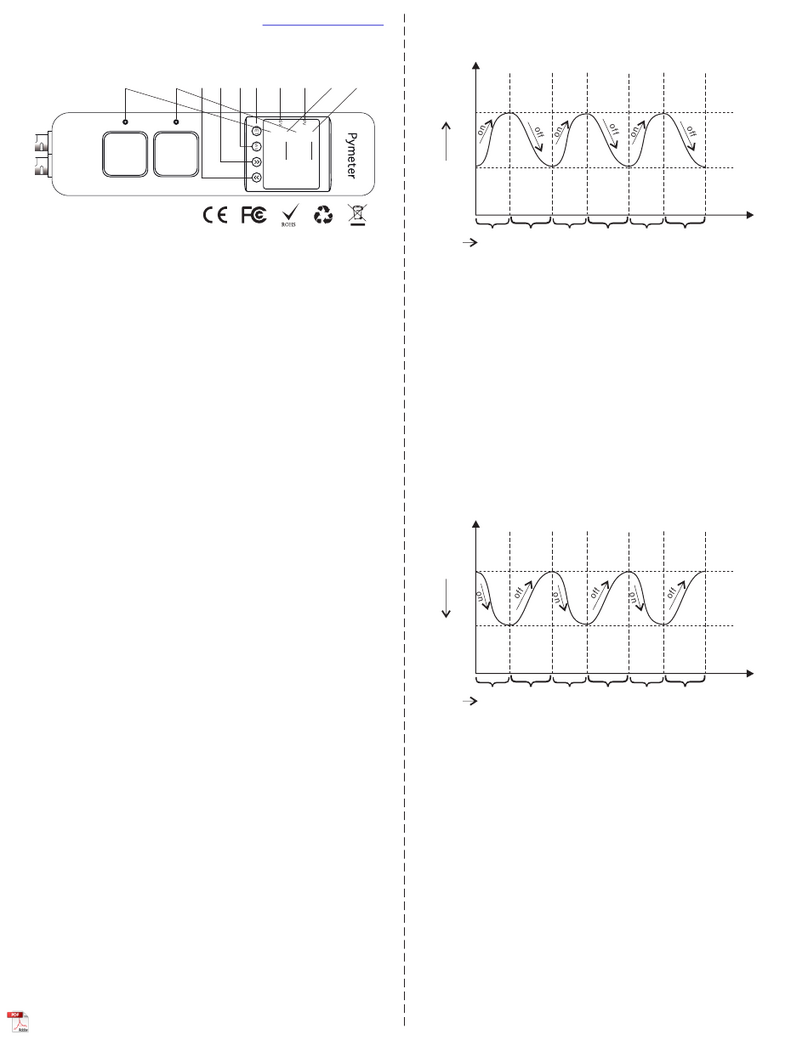
Pymeter
Pymeter PY-20TT quick start guide
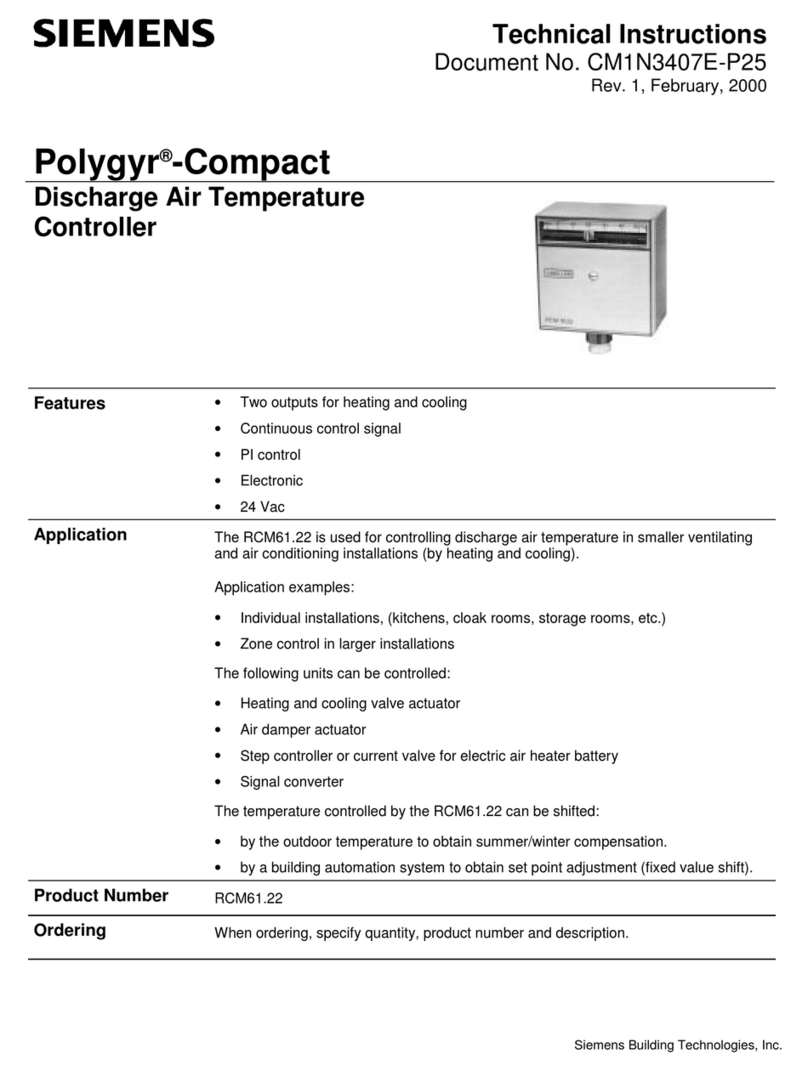
Siemens
Siemens Polygyr-Compact Technical instructions
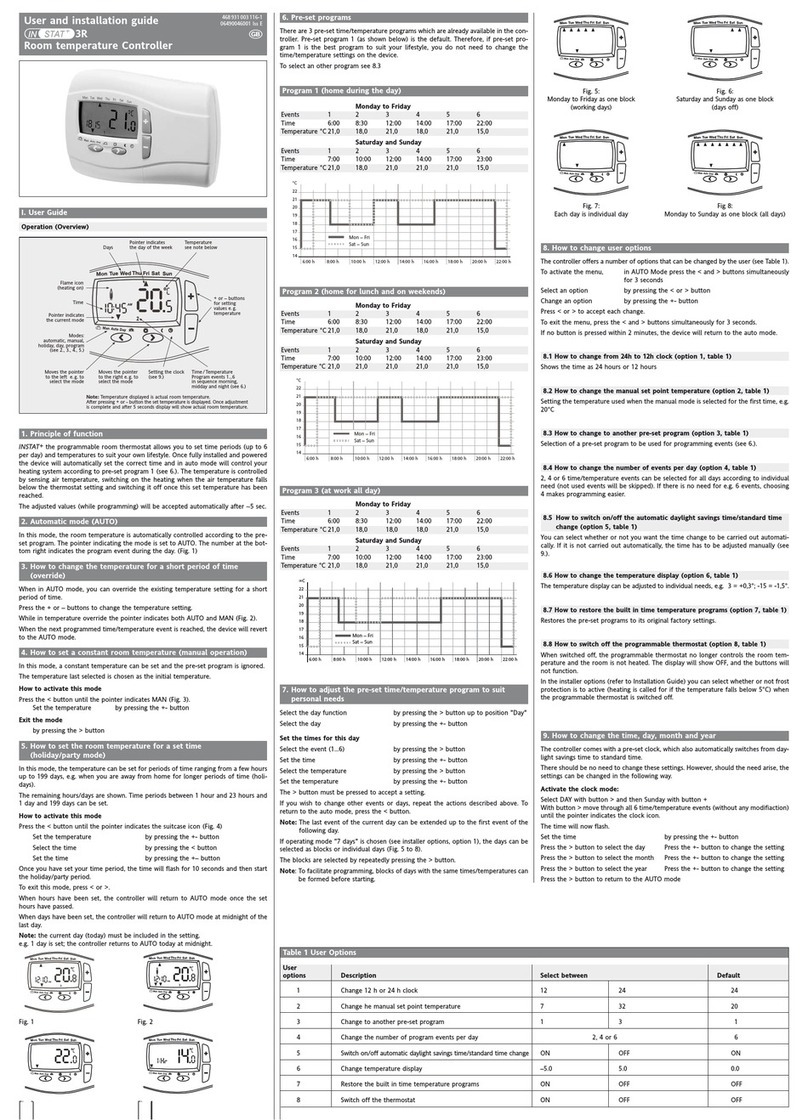
INSTAT+
INSTAT+ 3R User and installation guide
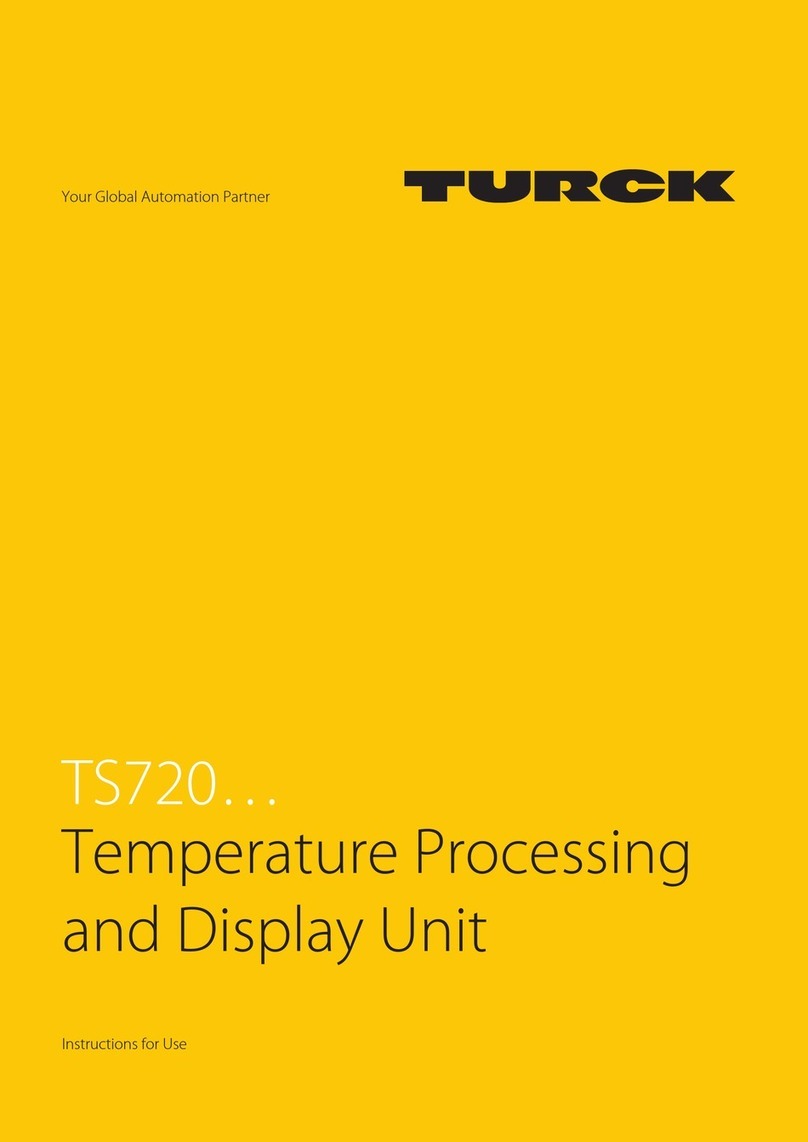
turck
turck TS720 Series Instructions for use
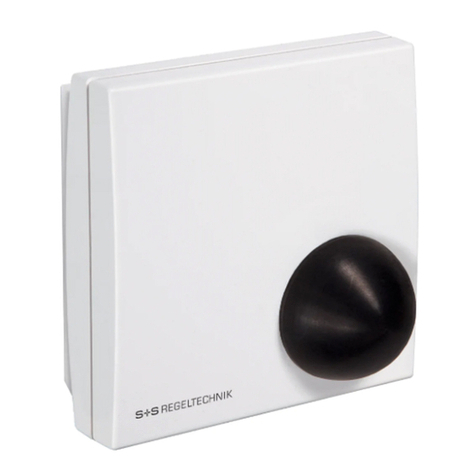
S+S Regeltechnik
S+S Regeltechnik THERMASGARD RSTF Operating Instructions, Mounting & Installation

ENDA
ENDA ET2011 manual

Honeywell
Honeywell ASC02-01WM Installation and operating instructions
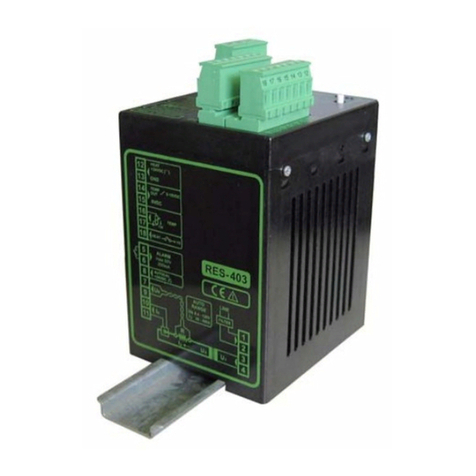
Ropex
Ropex RESISTRON RES-403 operating instructions
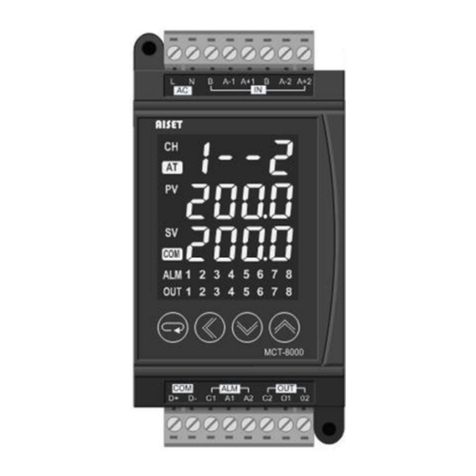
Yatai
Yatai XMTN-800 Series Operation manual
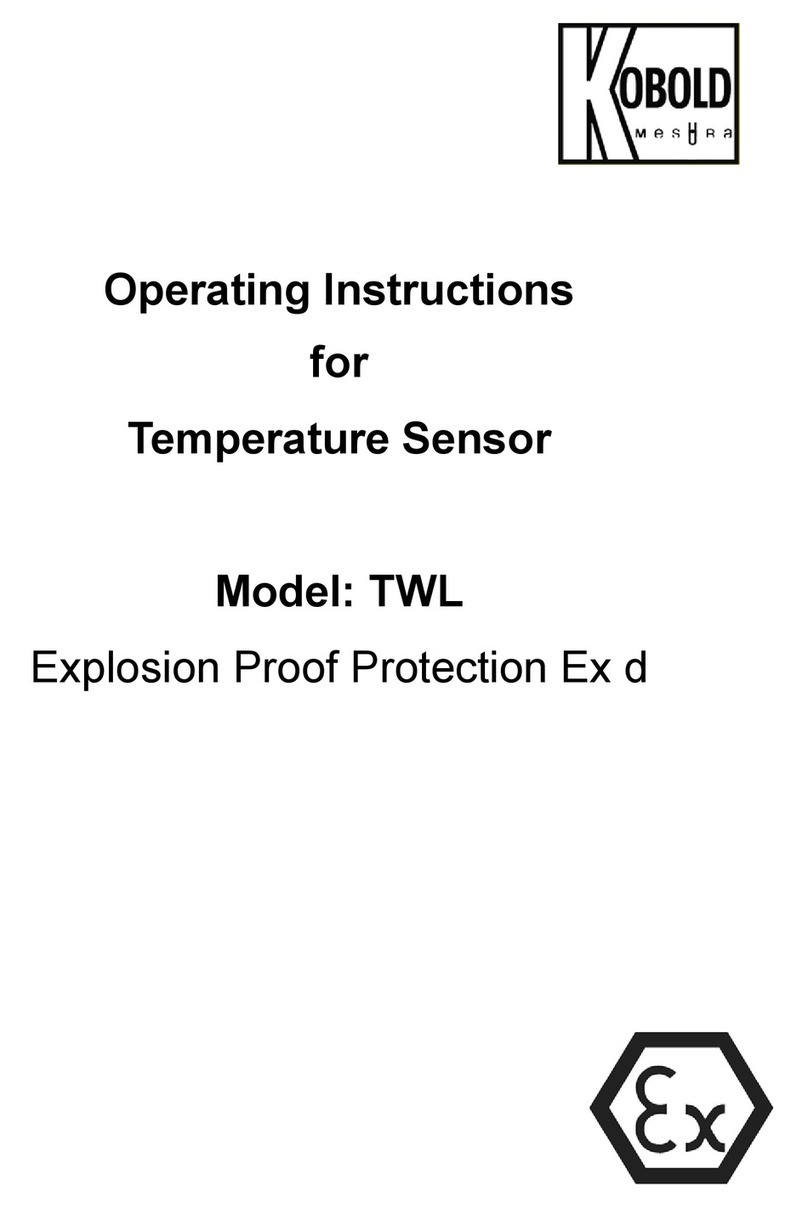
Kobold
Kobold TWL operating instructions
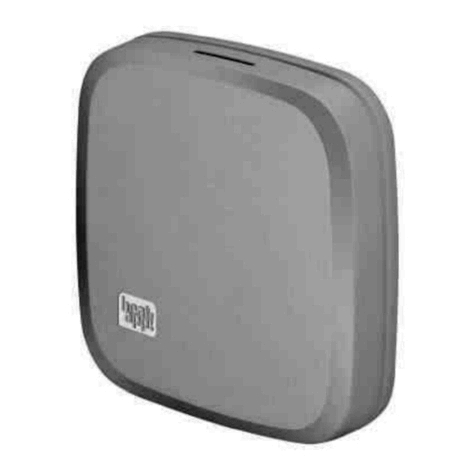
heatapp!
heatapp! sense-wire Installation instruction
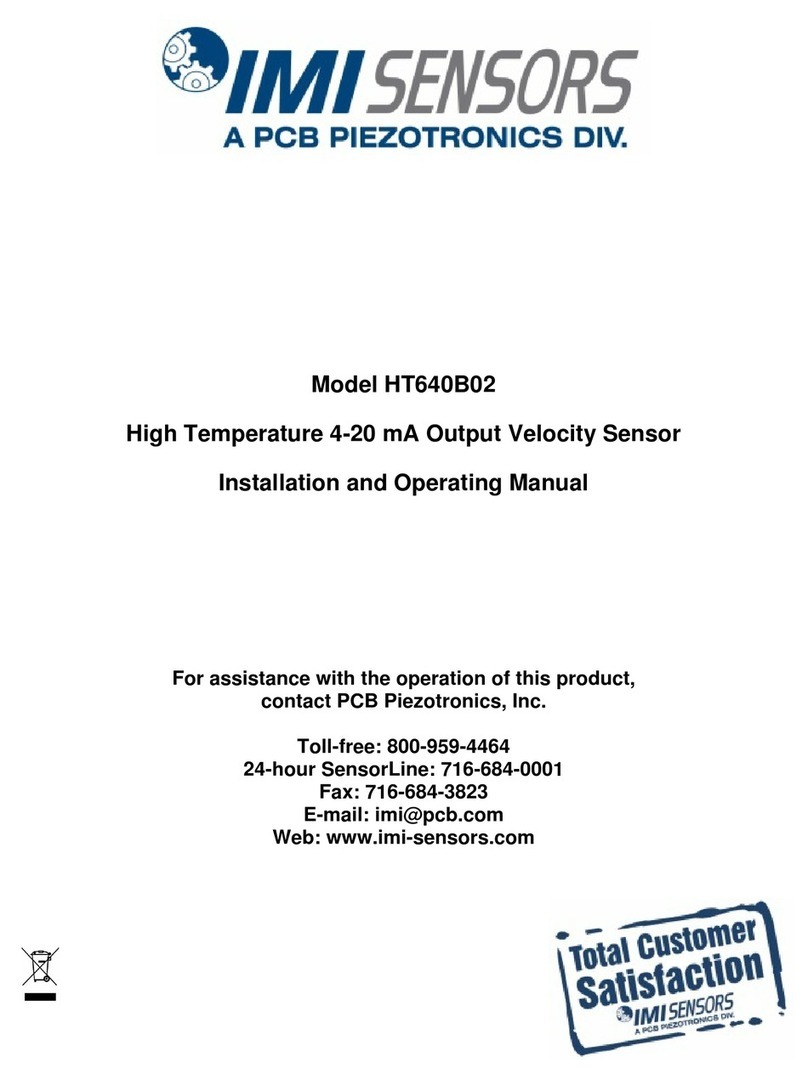
PCB Piezotronics
PCB Piezotronics IMI SENSORS HT640B02 Installation and operating manual


